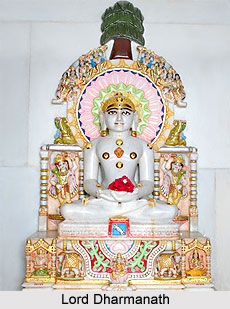 Shri Ratnapuri Teerth located in Uttar Pradesh is a Jain pilgrimage centre. It is situated in the Rohani Village. The nearest city from here is Sohaval. The temple is dedicated to Lord Dharmanath, the Fifteenth Jain Tirthankara,
Shri Ratnapuri Teerth located in Uttar Pradesh is a Jain pilgrimage centre. It is situated in the Rohani Village. The nearest city from here is Sohaval. The temple is dedicated to Lord Dharmanath, the Fifteenth Jain Tirthankara,
History of Shri Ratnapuri Teerth
According to history Shri Ratnapuri Teerth dates back to the ancient times. The teerth kshetra belongs to the time of Lord Dharmanth. The place has been sanctified by the four Kalyanakas of the Lord namely, chayavan, birth, diksha and attainment of Omniscience or Kevala Gyan. As per reference the Rohani village where the teerth is located was once a large city named Ratanpur. The land is regarded as very holy for being the land of Kalyanakas hence many earlier Jain temples had been built here dedicated to the Jain Tirthankaras. Shri Ratnapuri Teerth finds its mention in the `Vividh Tirthkalpa` written in the 14th century. The Lord is known by the name Dharmaraj by the local people here. The idol of Lord Dharmanatha is believed to possess miraculous powers. Devotees from far off places visit the temple to offer their prayers. It is believed that if prayed with all devotion the Lord fulfils the wishes of the pilgrims.
Temple of Shri Ratnapuri Teerth
The temple of Shri Ratnapuri Teerth houses the idol of Lord Dharmanath. The Digambara temple has been magnificently decorated with intricate artistic designs. The creative temple work boast about the skills of the craftsmen. The walls and pillars of the temple are adorned with specimens of ancient art. The idol of the Lord is 90 cm in height and is white in colour. It is seated in a padmasana posture. The idol has been beautifully carved from a single stone and looks very appealing. The smiling face of the Lord looks very calm and serene. Apart from this there is a pair of black coloured wooden sandals of Lord Dharmanath in a round marble disk. It looks very attractive and appealing. Other than this there are many other beautiful Swetambara temples and two Digambara temples located here. These temples are also tastefully decorated and are worth visiting.
The Temple of Shri Ratnapuri Teerth organises many annual gatherings and functions. There are provisions for dharamshalas or rest houses for the pilgrims. These are well equipped with all modern facilities. Apart from this there are Upashrays, an Ayambilshala and a Jnanabhandar. The temple is enclosed by scenic beauty that mesmerises and fascinates the pilgrims. The calm and tranquil environment and the surrounding greenery make it a suitable place for religious activities. The kshetra is well connected to road, rail and air. Taxi services and bus services are easily available here. The nearest bus stop is located at Faizabad at a distance of 18 km. The nearest railway station is located at Sohaval which is about 2 Km away. The nearest airport is situated at Lucknow. It is situated on Ayodhya-Barabanki Road.




















